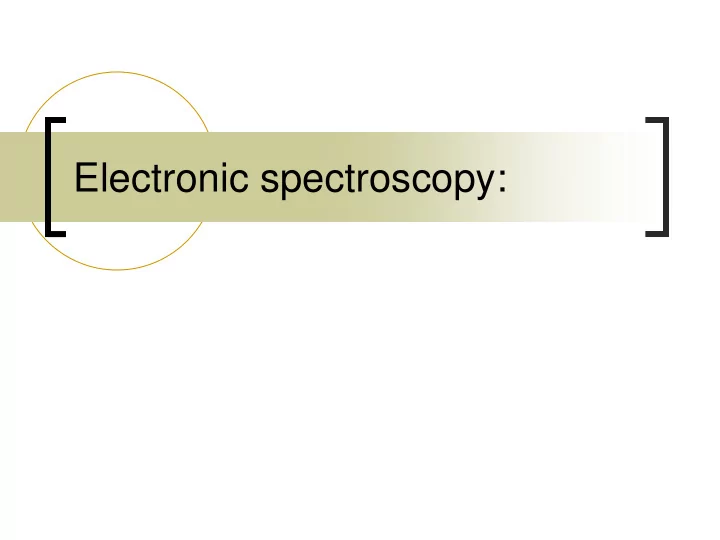

Electronic spectroscopy:
Electronic transitions UV/VIS transitions between discrete electronic states. Electrons promoted from ground state to excited state. C---O e- excited e-C — Oe- change bond order C---O vib -> vibrate faster C---O rot -> rotate faster Rotational and vibrational transitions accompany electronic transitions. Difficult to resolve all transitions Molecular Spectroscopy CEM 484 2
Energy level diagram Molecular Spectroscopy CEM 484 3
Vibronic transitions Total energy need to include terms from al three transitions. E total /hc = n ̃ elec + G( n ) + F(J) E total /hc = n ̃ elec + ( n +1/2) n ̃ e – ( n +1/2) 2 x ̃ e n ̃ e + B ̃ n [J(J+1)] – D ̃ J 2 (J+1) 2 Rotational and vibrational terms are comparatively small and not easily resolved. Ignoring rotations an expression for excitations between excited state n ̃ obs = E 1, n ’ – E g, n ’’= 0 / hc = v ̃’ e1 + ( n ’+ 1/2) n ̃’ e – ( n ’+ 1/2) 2 x ̃’ e n ̃’ e - {v ̃’’ e0 + n ̃’’ e /2 – x ̃’’ e n ̃’’ e /4 } Define: n 0,0 = ( n ̃ elec1 – n ̃ elec0 ) + n ̃’ e /2 – x' ̃ e n ̃’ e /4 – ( n ̃’’ e /2 – x ̃’’ e n ̃’’ e /4 ) n ̃ obs = n 0,0 + n ’ n ̃’ e – n ’( n ’+ 1)x ̃’ e n ̃’ e Molecular Spectroscopy CEM 484 4
Vibronic transitions Electronic energy spectrum of I 2 . Higher energy transitions become harder to resolve. Vibronic progression Molecular Spectroscopy CEM 484 5
Dissociation energy D o is dissociation energy. Measured from the first vibrational state Ground state is not at bottom of potential well. D ̃ o = -E total /hc – D ̃ e – n ̃ e /2 + x ̃ e n ̃ e /4 Molecular Spectroscopy CEM 484 6
Dissociation energies: Example The fundamental line in the infrared spectrum of 12 C 16 O occurs at 2143.0 cm -1 , and the first overtone is found at 4260 cm -1 . Calculate the values of ν e and ν e x e for 12 C 16 O. Molecular Spectroscopy CEM 484 7
Iclicker: Disociation energies The energy difference 4100 between two arbitrary 3900 levels n and n +1 is 3700 3500 D G (cm -1 ) D G = ṽ e (1 – 2x̃ e ( n + 1) ) 3300 The dissociation energy 3100 y = -228.63x + 4154.7 R² = 0.9999 can be written as 2900 2700 D ̃ e = ṽ e (1-x ̃ e 2 )/4x ̃ e ≈ 2500 ṽ e /4x ̃ e 0 1 2 3 4 5 6 7 v+1 Using the graph on right, estimate the dissociation energy for H 2 . Molecular Spectroscopy CEM 484 8
Electronic excitation intensity pattern Intensity pattern of electronic transitions reveals molecular structure. Franck-Condon principle Nuclei do not move appreciably during electron excitation Molecular Spectroscopy CEM 484 9
Iclicker: Label the curve Label the energy curve with: Vibration and rotational quantum numbers. The zero point energy for the ground electronic state. The fundamental vibrational frequency of the ground electronic state. The first overtone of the second electronic state. The dissociation energy of the second electronic state. The P-branch transition from the J=1, n =0 level in the ground electronic state. The R-branch transition from the J=1, n =0 level in the ground electronic state. Molecular Spectroscopy CEM 484 10
Recommend
More recommend